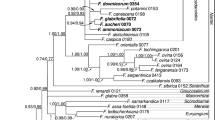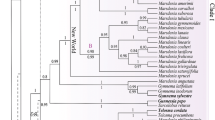Abstract
Prunus subgenus Padus is a group with a wide distribution in temperate eastern Asia and eastern North America with one species extending to Europe and one to Central America. Phylogenetic relationships of subgenus Padus were reconstructed using sequences of nuclear ribosomal ITS, and plastid ndhF gene, and rps16 intron and rpl16 intron. Prunus subgenus Padus is shown to be polyphyletic. Taxa of subgenus Padus and subgenus Laurocerasus are highly intermixed in both the ITS and the plastid trees. The results support two disjunctions between eastern North America and Eurasia within the Padus group. One disjunction is between Prunus virginiana of eastern North America and P. padus of Eurasia, estimated to have diverged at 2.99 (95 % HPD 0.59–6.15)–4.1 (95 % HPD 0.63–8.59) mya. The other disjunction is between P. serotina and its Asian relatives. The second disjunction may have occurred earlier than the former one, but the age estimate is difficult due to the unresolved phylogenetic position of the P. serotina complex.



Similar content being viewed by others
References
Benedict JC, DeVore ML, Pigg KB (2011) Prunus and Oemleria (Rosaceae) flowers from the late early Eocene republic flora of northwestern Washington State, USA. Int J Pl Sci 172:948–958
Bortiri ES, Oh H, Jiang JG, Baggett S, Granger A, Weeks C, Buckingham M, Potter D, Parfitt DE (2001) Phylogeny and systematics of Prunus (Rosaceae) as determined by sequence analysis of ITS and the chloroplast trnL-trnF spacer DNA. Syst Bot 26:797–807
Bortiri ES, Oh H, Gao F-Y, Potter D (2002) The phylogenetic utility of nucleotide sequences of sorbitol 6-phosphate dehydrogenase in Prunus (Rosaceae). Am J Bot 89:1697–1708
Bortiri ES, Vanden B, Potter D (2006) Phylogenetic analysis of morphology in Prunus reveals extensive homoplasy. Pl Syst Evol 259:53–71
Chaney RW (1947) Tertiary centers and migration routes. Ecol Monogr 17:140–148
Chin SW, Wen J, Johnson G, Potter D (2010) Merging Maddenia with the morphologically diverse Prunus (Rosaceae). Bot J Linn Soc 164:236–245
de Tournefort JP (1700) Institutiones Rei Herbariae, Typograhia Regia, Paris
DeVore ML, Pigg KB (2007) A brief review of the fossil history of the family Rosaceae with a focus on the Eocene Okanogan Highlands of eastern Washington State, USA, and British Columbia, Canada. Pl Syst Evol 266:45–57
Drummond AJ, Rambaut A (2007) BEAST: Bayesian evolutionary analysis by sampling trees. BMC Evol Biol 7:214
Drummond AJ, Ho SYW, Phillips MJ, Rambaut A (2006) Relaxed phylogenetics and dating with confidence. PLoS Biol 4:699–710
Farris JS, Kallersjo M, Kluge AG, Bult C (1994) Testing significance of incongruence. Cladistics 10:315–319
Felsenstein J (1985) Confidence limits on phylogenies: an approach using the bootstrap. Evolution 39:783–791
Focke WO (1894) Rosaceae. In: Engler A, Prantl K (eds) Die Natürlichen Pflanzenfamilien nebst ihren Gattungen und wichtigeren Arten insbesondere den Nutzpflanzen unter Mitwirkung zahlreicher hervorragender Fachgelehrten, vol 3, No. 3. Verlag von Wilhelm Engelmann, Leipzig, pp 1–61
Geng BY, Tao JR, Xie GP (2001) Early Tertiary fossil plants and paleoclimate of Lanzhou basin. Acta Phytotax Sin 39:105–115
Hiraishi A, Kamagata Y, Nakamura K (1995) Polymerase chain reaction amplification and restriction fragment length polymorphism analysis of 16S rRNA genes from methanogens. J Ferment Bioeng 79:523–529
Iwatsubo Y, Kawasaki T, Naruhashi N (2002) Chromosome numbers of 193 cultivated taxa of Prunus. J Phytogeogr Taxon 50:21–34
Iwatsubo Y, Sengi Y, Naruhashi N (2004) Chromosome numbers of 36 cultivated taxa of Prunus subg. Cerasus in Japan. Taxon 52:73–76
Iwatsuki K, Ohba H (1994) The floristic relationship between East Asia and eastern North America. In: Miyawaki A, Iwatsuki K, Grandtner MM (eds) Vegetation in eastern North America. Univ. Tokyo Press, Tokyo, pp 61–74
Kalkman C (1965) The Old Worlds species of Prunus subgen. Laurocerasus including those formerly referred to Pygeum. Blumea 13:1–115
Koehne E (1893) Deutsche Dendrologie. Verlag von Ferdinand Enke, Stuttgart
Koehne E (1911) Die Gliederung von Prunus subgen. Padus. Abhandl Bot Ver Brandenburg 52:101–108
Koehne E (1915) Zur Kenntnis von Prunus Grex Calycopadus und Grex Gymnopadus sect. Laurocerasus. Bot Jahrb 52:279–333
Komarov L (1971) Rosaceae: Rosoideae, Amygdaloideae. In: Flora of the U.S.S.R, English translation, vol 10. Smithsonian Institution, Washington, DC, pp 1–512
Kress WJ, Penev L (2011) Innovative electronic publication in plant systematics: PhytoKeys and the changes to the “Botanical Code” accepted at the XVIII International Botanical Congress in Melbourne. PhytoKeys 6:1–4
Lee S, Wen J (2001) A phylogenetic analysis of Prunus and the Amygdaloideae (Rosaceae) using ITS sequences of nuclear ribosomal DNA. Am J Bot 88:150–160
Li HL (1952) Floristic relationships between eastern Asia and eastern North America. Am Phil Soc 42:371–429
Li Y, Smith T, Liu C-J, Awasthi N, Yang J, Wang Y-F, Li C-S (2011) Endocarps of Prunus (Rosaceae: Prunoideae) from the early Eocene of Wutu, Shandong Province, China. Taxon 60:555–564
Linnaeus C (1754) Genera plantarum, 5th edn, Weinhein/Bergstr, HR Englemann (J Cramer), New York, Hafner Pub Co
Lu LL, Gu CZ, Li CL, Alexander C, Batholomew B, Brach AR, Boufford DE, Ikeda H, Ohba H, Robertson KR, Spongberg S (2003) Rosaceae. In: Wu ZY, Raven PH, Hong DY (eds) Flora of China, vol 9. Science Press, Beijing and Missouri Botanical Garden Press, St. Louis, pp 46–434
Magallón S, Castillo A (2009) Angiosperm diversification through time. Am J Bot 96:349–365
McKenna MC (1975) Fossil mammals and early Eocene North Atlantic land continuity. Ann Missouri Bot Gard 62:335–353
McKenna MC (1983) Cenozoic paleogeography of North Atlantic land bridges. In: Bott MHP, Saxov S, Talwani M, Thiede J (eds) Structure and development of the Greenland–Scotland ridge. Plenum Press, New York, pp 351–399
McVaugh R (1951) A revision of the North America black cherries (Prunus serrotina Ehrh, and relatives). Brittonia 7:279–315
McVaugh R (1952) Suggested phylogeny of Prunus serotina and other wide-ranging phylads in North America. Brittonia 7:317–346
Mehra PN, Sareen TS, Hans AS (1973) Cytology of some woody species of Rosaceae from the Himalayas. Silvae Genet 22:188–190
Miller P (1754) The gardener’s dictionary, 4th edn, John and James Rivington, London
Miquel FAG (1865–1867) Prolusio florae Japonicae. In: Miquel, Annales Musei Botanici Lugduno-Bataui, Vol 2, Amstelodami, pp. 69–212, 257–300
Mohr C (1899) Notes on some new and little known plants of the Alabama flora. Bull Torrey Bot Club 26:118–121
Ohta S, Yamamoto T, Nishitani C, Katsuki T, Iketani H, Omura M (2007) Phylogenetic relationship among Japanese flowering cherries (Prunus subgenus Cerasus) based on nucleotide sequences of chloroplast DNA. Pl Syst Evol 263:209–225
Olmstead RG, Sweere JA (1994) Combining data in phylogenetic systematics: an empirical approach using three molecular data sets in the Solabaceae. Syst Biol 43:467–481
Posada D, Buckley TR (2004) Model selection and model averaging in phylogenetics: advantages of Akaike information criterion and Bayesian approaches over likelihood ratio tests. Syst Biol 53:793–808
Posada D, Crandall KA (1998) Modeltest: testing the model of DNA substitution. Bioinformatics 14:817–818
Potter D, Eriksson T, Evans RC, Oh S, Smedmark JEE, Morgan DR, Kerr M, Robertson KR, Arsenault M, Dickinson TA, Campbell CS (2007) Phylogeny and classification of Rosaceae. Pl Syst Evol 266:5–43
Rambaut A (2007) Se-Al: sequence alignment editor, version 2.0a11. http://tree.bio.ed.ac.uk/software/seal/
Rambaut A, Drummond AJ (2007) Tracer version 1.5. http://beast.bio.ed.ac.uk/Tracer
Rannala B, Yang Z (1996) Probability distribution of molecular evolutionary trees: a new method of phylogenetic inference. J Mol Evol 43:304–311
Rehder A (1940) A manual of cultivated trees and shrubs hardy in North America exclusive of the subtropical and warmer temperate regions, 2nd edn. Macmillan, New York
Robertson KR (1974) The genera of Rosaceae in the southeastern United States. J Arnold Arbor 55:344–401
Roemer MJ (1847) Familiarumn aturaliumr egni vegetabilis synopses monographicae, vol 4, Landes-Industrie-comptoir, Weimar
Ronquist F, Huelsenbeck JP (2003) Mrbayes 3: Bayesian phylogenetic inference under mixed models. Bioinformatics 19:1572–1574
Shaw J, Small RL (2004) Addressing the “hardest puzzle in American pomology”: phylogeny of Prunus sect. Prunocerasus (Rosaceae) based on seven noncoding chloroplast DNA regions. Am J Bot 91:985–996
Shaw J, Small RL (2005) Chloroplast DNA phylogeny and phylogeography of the North American plums (Prunus subgenus Prunus section Prunocerasus, Rosaceae). Am J Bot 92:2011–2030
Suzuki M (1984) Some fossil woods from the Palaeogene of northern Kyushu, III. Bot Mag Tokyo 97:457–468
Swofford DL (2003) PAUP: phylogenetic analysis using parsimony (and other methods). Sinauer Associates, Sunderland
Takahashi A, Suuzki M (1988) Two new fossil woods of Acer and a new combination of Prunus from the tertiary of Japan. Bot Mag Tokyo 101:473–481
Takhtajan AL (1987) Systema Magnoliophytorum. Academy of Sciences U.S.S.R, Leningrad
Thompson JD, Gibson TJ, Plewniak F, Eanmougin F, Higgins DG (1997) The ClustalX Windows interface: flexible strategies for multiple sequence alignment aided by quality analysis tools. Nucl Acids Res 24:4876–4882
Tiffney BH (1985a) The Eocene North Atlantic land bridge: its importance in Tertiary and modern phytogeography of the northern hemisphere. J Arnold Arbor 66:243–273
Tiffney BH (1985b) Perspectives on the origin of the floristic similarity between Eastern Asia and eastern North America. J Arnold Arbor 66:73–94
Watkins R (1976) Cherry, plum, peach, apricot and almond. In: Simmons NW (ed) Evolution of crop plants. Longman, London, pp 242–247
Weakley AS (2006) Flora of the Carolinas, Virginia, Georgia and surrounding areas [draft]. University of North Carolina Herbarium, Chapel Hill
Webb DA (1968) Prunus. In: Tutin TG, Heywood VH, Burges NA, Moore DM, Valentine DH, Walters SM, Webb DA (eds) Flora Europaea, vol 2. Cambridge University Press, Cambridge, pp 77–80
Wen J (1998) Evolution of the eastern Asian and eastern North American disjunct pattern: insights from phylogenetic studies. Korean J Plant Taxon 28:63–81
Wen J (1999) Evolution of eastern Asian and eastern North American disjunct distributions in flowering plants. Ann Rev Ecol Syst 30:421–455
Wen J (2001) Evolution of eastern Asian and eastern North American biogeographic pattern: a few additional issues. Int J Pl Sci 162:S117–S122
Wen J, Zimmer EA (1996) Phylogeny and biogeography of Panax L. (the ginseng genus, Araliaceae): inferences from ITS sequences of nuclear ribosomal DNA. Mol Phylogenet Evol 6:166–177
Wen J, Berggren ST, Lee CH, Ickert-Bond S, Yoo K-O, Xie L, Shaw J, Potter D (2008) Phylogenetic inferences in Prunus (Rosaceae) using chloroplast ndhF and nuclear ribosomal ITS sequences. J Syst Evol 46:322–332
Wen J, Ickert-Bond S, Nie ZL, Li R (2010) Timing and modes of evolution of eastern Asian—North American biogeographic disjunctions in seed plants. In: Long M, Gu H, Zhou Z (eds) Darwin’s heritage today: proceedings of the Darwin 200 Beijing international conference. Higher Education Press, Beijing, pp 252–269
Wheeler EA, Richard RA, Barghoorn ES (1978) Fossil dicotyledonous woods from Yellowstone National Park II. J Arnold Arbor 59:1–31
Wolfe JA (1972) An interpretation of Alaskan Tertiary floras. In: Graham A (eds) Floristics and paleoflorostics of Asia and eastern North America. Elsevier Publishing Company, Amsterdam, pp 201–233
Yü TT, Lu LT, Ku TC, Li CL, Chen SX (1986) Rosaceae 4. Prunoideae Focke. In: Yü TT (ed) Flora Reipublicae Popularis Sinicae, vol 38. Science Press, Beijing, pp 1–133
Zhang SY (1992) Systematic wood anatomy of the Rosaceae. Blumea 37:81–158
Acknowledgments
We thank John Clark, Tao Deng, Michael Dillon, Steve Ginzsbarg, Ruth Kiew, Sue Lutz, Ying Meng, Michael Nee, Elizabeth Widjaja, Tingshuang Yi, Tze Leung Yao, and Zhuo Zhou for assistance in obtaining samples and/or field assistance. The study was supported by the China Scholarship Council, the National Science Foundation (NSF Award number DEB 0515431), the Natural Science Foundation of China (Project no. 30625004 to J. Wen and T. Yi), the Smithsonian Endowment Program, the National Natural Science Foundation of China (Grant no. 31129001), and the Laboratory of Analytical Biology of the National Museum of Natural History, the Smithsonian Institution. Staff of the Arnold Arboretum of Harvard University kindly provided samples for the study.
Author information
Authors and Affiliations
Corresponding authors
Electronic supplementary material
Below is the link to the electronic supplementary material.
Rights and permissions
About this article
Cite this article
Liu, XL., Wen, J., Nie, ZL. et al. Polyphyly of the Padus group of Prunus (Rosaceae) and the evolution of biogeographic disjunctions between eastern Asia and eastern North America. J Plant Res 126, 351–361 (2013). https://doi.org/10.1007/s10265-012-0535-1
Received:
Accepted:
Published:
Issue Date:
DOI: https://doi.org/10.1007/s10265-012-0535-1




